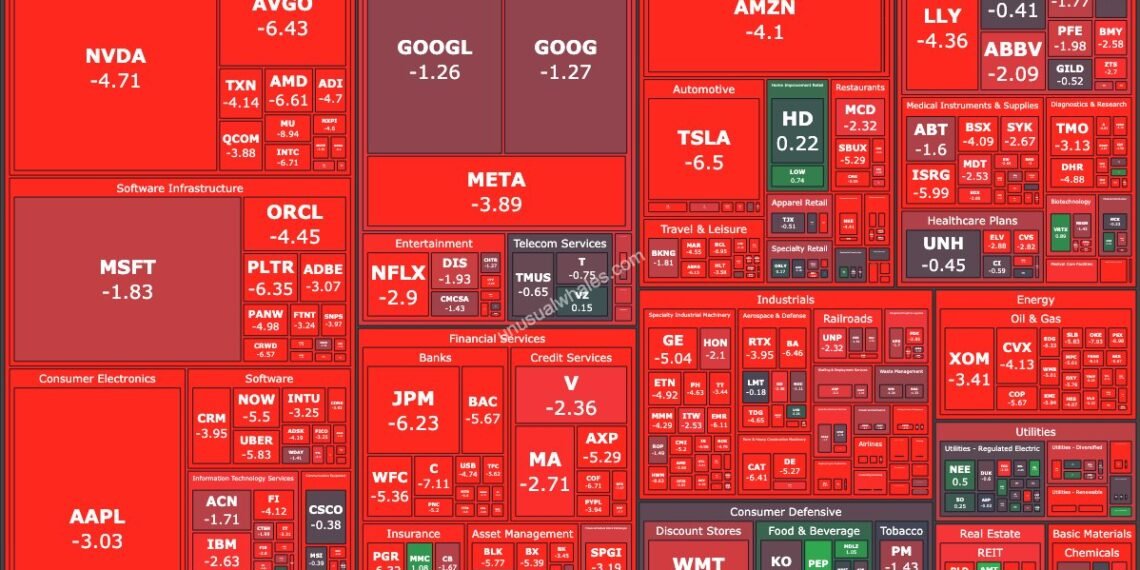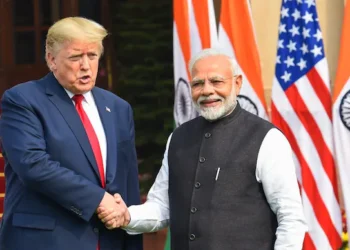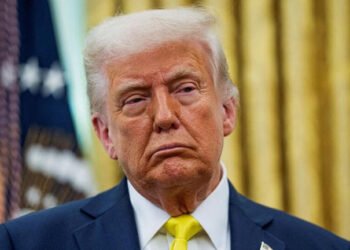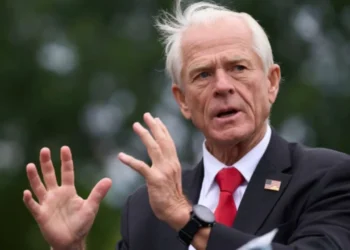“Trump’s bold tariff gambit against major trading partners backfired spectacularly, sending the S&P 500 down 6% on April 3 and another 5% on April 4. As several countries back with their own levies, Wall Street’s two-day nightmare erased gains and exposed the perils of escalating Trade War 2.0.”
BY PC Bureau
On April 3 and 4, 2025, the U.S. financial markets endured a brutal two-day sell-off, shedding over 11% in value following President Donald Trump’s announcement of sweeping tariffs against a broad swath of countries, including Japan, India, and others. The S&P 500, Dow Jones Industrial Average, and Nasdaq Composite collectively hemorrhaged wealth at a pace unseen since the 2008 financial crisis, as global trade tensions erupted into a full-blown economic firestorm. What began as a policy gambit to reshape America’s trade landscape morphed into a market rout that erased trillions of dollars and stoked fears of a global recession.
April 3, 2025: The First Blow – A 6% Market Drop
The chaos kicked off on April 3, one day after Trump’s tariff announcement on April 2. Speaking from the White House, the president unveiled a 10% baseline tariff on all U.S. imports, effective April 5, with additional punitive levies targeting specific nations: 54% on China, 25% on Canada and Mexico (with some USMCA exemptions), 20% on Japan, 15% on India, and a sliding scale of duties on the European Union and other trading partners. Trump pitched the move as a defense against “unfair trade practices,” illegal immigration, and economic threats, promising to “bring jobs and wealth back to America.”
Wall Street, however, saw it differently. By the opening bell on April 3, panic had already set in. The Dow futures were down 1,000 points pre-market, and when trading began, the carnage unfolded rapidly. The S&P 500 closed the day down 6%, losing 330 points to settle at approximately 5,170 (based on late March levels). The Dow Jones Industrial Average cratered 1,950 points—a 5.8% decline—while the Nasdaq Composite, heavily weighted toward tech firms reliant on global supply chains, plunged 6.5%, shedding over 1,200 points.
ALSO READ: Rights Group Accuses BIMSTEC Nations of Arming Myanmar Junta Amidst Summit
The sell-off was indiscriminate but hit certain sectors hardest. Tech giants like Apple and Nvidia, with deep ties to Japanese and Chinese manufacturing, saw double-digit declines—Apple down 11% and Nvidia off 13.5%. Automakers Ford and General Motors, reeling from the Japan and Mexico tariffs, dropped 9% and 10%, respectively, as investors feared disruptions to their just-in-time supply chains. Retailers like Walmart and Target, dependent on imports from India and Southeast Asia for apparel and consumer goods, fell 8% and 7%, signaling higher costs ahead.
So, Wall Street suffers biggest two-day market crash EVER…
Yep, the ‘deliberate market manipulation’ is in effect
And Trump’s tariffs, they will blame
However, if you were awake knowing what was coming, and went to cash, the time to buy is soon at hand~ 😎 pic.twitter.com/3vcJFZnmmd
— TruthInBytes (@bytesintruth) April 4, 2025
The global response amplified the damage. Japan, facing a 20% tariff, saw its Nikkei 225 futures slide 4% overnight, with Toyota and Sony bracing for export losses. India’s Sensex dropped 3.5% as its textile and pharmaceutical sectors—key U.S. suppliers—faced a 15% levy. China, already a tariff veteran, promised “decisive countermeasures,” while Canada and Mexico began drafting retaliatory plans. The U.S. dollar weakened 2% against a basket of currencies, reflecting fears of trade isolation, and crude oil prices fell 5% as global demand forecasts dimmed.
MUST READ: Tibet “Hell” Under China: Report Details Decade of Excesses
By day’s end, the market had lost an estimated $3 trillion in value, according to Bloomberg data. Investors fled to safe havens—gold surged to $3,050 per ounce, and the 10-year Treasury yield dipped to 4.20% from 4.80% in late March. Analysts pointed to the tariffs’ breadth as the trigger: unlike Trump’s first-term focus on China, this move ensnared nearly every major U.S. trading partner, threatening a supply chain meltdown.
April 4, 2025: The Second Strike – Over 5% More Lost
If April 3 was a warning shot, April 4 was a full-on collapse. Markets opened with a flicker of hope—futures suggested a modest rebound as some traders bet on a dip-buying opportunity. But that optimism evaporated as retaliatory measures from affected nations rolled in, confirming the worst fears of a global trade war.
China struck first, announcing a 34% tariff on all U.S. goods effective April 6, targeting agriculture (soybeans, corn, pork) and energy (LNG, crude oil). Japan followed, slapping a 25% duty on U.S. autos and machinery, while India countered with a 20% tariff on American tech hardware and agricultural products like almonds and apples. Canada and Mexico, still smarting from the 25% levy, outlined plans to hit $50 billion and $30 billion in U.S. exports, respectively, with specifics to be finalized by April 7. The EU, not to be outdone, threatened 150% duties on U.S. whiskey, Harley-Davidson motorcycles, and Levi’s jeans.
1929: stock market crashes
US government raises tariffs
Result >The Great Depression2025: US government raises tariffs
stock market crashes
Result > Trump makes everyone rich?“Those who cannot remember the past are condemned to repeat it.”#stockmarketcrash pic.twitter.com/4FIjQX7xZC
— Liam Alexander💉x6 (@liamalexander) April 4, 2025
The S&P 500, already battered, fell another 5.2%—roughly 270 points—closing near 4,900, bringing its two-day loss to 11.2%. The Dow shed 1,679 points (4.9%), ending at approximately 32,600, while the Nasdaq dropped 5.5%, losing another 900 points to hover around 15,400—a cumulative 12% plunge over 48 hours. The VIX, Wall Street’s “fear gauge,” spiked to 35, its highest since 2022, signaling extreme volatility.
Sectoral damage deepened. Semiconductor firms like Intel and AMD, reliant on Japanese and Indian components, fell 12% and 14%, respectively, over the two days. Energy stocks Exxon Mobil and Chevron slumped 6% on April 4 alone as oil prices hit a six-month low of $72 per barrel. Consumer discretionary stocks—think Amazon and Home Depot—tumbled as analysts predicted a 3-5% price hike on imported goods, eroding consumer spending power. Even defensive sectors like utilities and healthcare, which held up on April 3, succumbed to the broader panic.
The economic toll was stark. The Federal Reserve Bank of Atlanta slashed its Q2 GDP growth estimate from 2.1% to -0.5%, factoring in trade disruptions. Goldman Sachs pegged the recession odds at 40% within a year, warning of a potential 20% S&P 500 drop from its March peak if tariffs persisted. Inflation fears resurfaced, with economists estimating a 1-2% price surge by summer, complicating the Fed’s next moves—traders now expect three to four rate cuts by year-end, starting in July.
The Bigger Picture
Trump remained unbowed. Departing for Mar-a-Lago on April 4, he called the market reaction “overblown” and predicted a swift recovery once “countries come to the table.” Treasury Secretary Scott Bessent echoed this, blaming “speculative algorithms” and foreign actors for the sell-off, while Vice President JD Vance insisted the tariffs would force nations to “play fair.” Yet, the administration’s defiance clashed with reality: with Japan, India, China, and others digging in, the risk of a prolonged trade war loomed large.
For investors, the two-day rout—over 11% wiped from the S&P 500—marked a turning point. The market, trading at 20 times forward earnings even after the crash, remained vulnerable to further declines if retaliation escalated. Gold hit $3,128 per ounce, and the dollar weakened another 1.5% on April 4, its worst two-day stretch since 2023. Consumer confidence, already shaky, hit a three-year low, per the Conference Board.
The April 3-4 crash exposed the fragility of a globalized economy under tariff strain. While some see Trump’s move as a negotiating ploy—recalling his first-term tariff rollbacks—others warn of a deeper unraveling. With supply chains stretched, inflation brewing, and retaliation mounting, the U.S. faces a precarious path. For now, Wall Street holds its breath, wondering if this is a storm to weather or the start of a long, dark winter.













